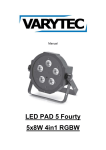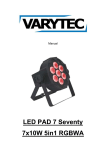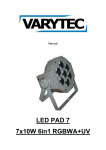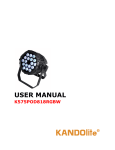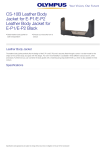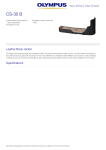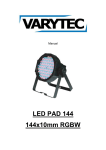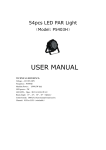Download Talent BL252 LED Linear Strip Lighting Bar Manual
Transcript
TABLE OF CONTENTS 1. Safety Instructions 2. Technical Specifications 3. Installation 4. How to Connect the Fixture 5. DMX512 Configuration 6. DMX512 Connections 7. How to Set the Unit 8. Troubleshooting 9. DMX General Information 1. Safety Instructions • Please keep this User Manual for future consultation. If you sell the fixture, be sure to include this instruction booklet to ensure proper maintenance and use. • Unpack and check carefully for transportation damage before using the fixture. • Before operating, ensure that the power supply voltage and frequency match the power of your electrical system. • It's important to connect the yellow/green conductor to ground to avoid electric shock. • Disconnect main power before servicing and maintenance. • Use a safety cable when permanently mounting this fixture. Always handle the fixture with care. • Maximum ambient temperature is 104° F. • In the event of a serious operating problem, stop using the fixture immediately. Please contact the dealer from whom you purchased the fixture or Talent Sound & Lighting directly. • Do not connect the device to any dimmer pack. • Do not touch exposed wires during use, as there might be a hazard of electrical shock. • To prevent or reduce the risk of electrical shock or fire, do not expose the fixture to rain or moisture. • The fixture must be replaced if there is visible damage to the housing. • Do not look directly at the LEDs while the fixture is on. Warning: Please read the instructions carefully. They include important information about installation, operation, and maintenance. Do not connect more than 32 units in series (daisy-chaining) on a single power circuit. Caution: There are no user serviceable parts inside the fixture. Do not open the housing or attempt any repairs yourself. In the unlikely situation your unit may require service, please contact your dealer or Talent Sound & Lighting. 2. Technical Specifications • DMX channels: 2/7/10/31 • 252 Ultra Bright 10 mm LEDs (Red: 63, Green: 63, Blue: 63, White: 63) • Auto, sound active, DMX, and master/slave modes • Internal programs with sound activation • IEC power in/out sockets • 3-pin XLR in/out sockets for DMX control • Slimline robust aluminum housing • RGBW color mixing • Beam angle: 40° • Power consumption: 23 watts • Dimension: 42.91" L x 2.64" H x 2.64" W • Weight: 4.07 lbs. 3. Installation The unit should be mounted via its screw holes on the bracket. Always ensure that the unit is installed to avoid vibration while operating. Always ensure that the structure to which you are attaching the unit is secure and is able to support a weight of 10x this fixture's weight (40.7 lbs.) Always use a safety cable that can hold 12x the weight of the fixture. 4. How to Connect the Fixture 3-Pin and 5-Pin XLR DMX Connectors: Some manufactures use 5-pin XLR connectors for data transmission. 5-pin XLR fixtures may be implemented in a 3-pin XLR DMX line. When inserting standard 5-pin XLR connectors into a 3-pin line, a cable adapter must be used. 5. DMX512 Connections DMX512 is a widely used protocol for intelligent lighting control, with 512 available channels. Even if you do not wish to operate your Talent lighting fixture via an outboard DMX controller, utilizing the master/slave mode will still require unit-to-unit connection by proper DMX cables. 6. How to Set the Unit Your Talent Sound & Lighting fixture may be operated as a stand-alone device that runs on pre-programmed routines or sound activation, in master/slave mode with other devices, or via an external DMX512 controller. In DMX mode it is configurable to be controlled by 2, 7, 10, or 31 channels. 6.1 Control Panel • If you are using a controller with 5-pin DMX output, use a 5-pin to 3-pin adapter cable. • Connect fixtures together in a "daisy chain" by connecting the DMX output of the first fixture to the DMX input of the next fixture. This cable cannot be branched or split by a "Y" cable. • The DMX output and input connectors are pass-through to maintain the DMX circuit if power to one of the units is disconnected. • On the last fixture, the DMX output should be terminated with a terminator with a 120 ohm resistor between pins 2 and 3 to reduce signal errors. 6.2 Main Functions Sound Active Modes: Mic sensitivity is adjustable on a 0 to 9 scale. Two sound active modes containing 10 effects each may be selected. Use the <UP> button to scroll through the dB meter and sound active modes (1st & 2nd digits) on the menu, and the <DOWN> button to adjust the program (3rd & 4th digits). S --- <ENTER> Sound Active Modes S000 - S009 dB Meter Adjusts Microphone Sensitivity S100 - S109 Sound Active 1, Silence Starts the Effect S200 - S209 Sound Active 2, Silence Stops the Effect Slave Mode 1.) To configure the fixture as a slave unit, scroll to A---, and select <ENTER>. Use the <UP/DOWN> buttons to navigate to A 0n. Press the <ENTER> button once again to confirm the setting. Manual Color Adjustment: Controls color balance. All other modes are affected by these global settings. r255: r000 - r255 Red Custom Color Adjustment G255: G000 - G255 Green Custom Color Adjustment b255: b000 - b255 Blue Custom Color Adjustment U255: U000 - U255 White Custom Color Adjustment 1.) The <MENU> and <UP/DOWN> button may be used to select rL-(Red Level), GL-- (Green Level), bL-- (Blue Level), or UL-- (White Level). Using the <UP/DOWN> buttons, select the maximum level for each color, x000x255 (000 = off), then press <ENTER> to confirm the setting. DMX Mode The unit is controllable by most brands of DMX controller. Each lighting fixture needs to have an address set when in DMX mode, to receive the data sent by the controller. The address number is between 0-511 (usually 0 & 1 are equal to 1). 1.) The default starting DMX address for the fixture is A001 on the LED readout. To select a different starting DMX address, use the <UP/DOWN> buttons to select the starting address you wish to use, and press the <ENTER> button to confirm your choice. 2.) To select which channel mode you would like to use, set the value of DMX Channel 1 as desired. 7. DMX512 Configurations 8. Troubleshooting Here are some troubleshooting suggestions: A. The fixture does not work, there is no light output. 1.) Check the connection of power and main fuse. 2.) Measure the voltage output on your power receptacle to ensure proper voltage. B. Fixture does not respond to DMX control. 1.) DMX LED should be on. If not, check DMX connectors and cables for proper connection. 2.) If DMX LED is on but not responding to a channel, check the DMX address settings and DMX polarity. 3.) If you have intermittent DMX signal problems, check the pins on the cable connectors and on the fixture. 4.) Try to use a different DMX controller. 5.) Ensure DMX cables aren't run along high voltage cables. C. Fixture responds erratically to DMX control. 1.) You may have a break in the DMX cabling. Check the LED for the response of the master/ slave mode signal. 2.) Wrong DMX address in the fixture. Set the fixture to the proper address. 3.) Use of microphone cables for DMX connections can cause errors D. The fixture doesn't respond to sound. 1.) Make sure the fixture is not set to receive a DMX signal. 2.) Check the fixture's internal microphone by tapping the microphone. For additional details about DMX operation, please review Section 9: DMX General Information. 9. DMX General Information The DMX standard features 512 available channels. Each DMX-capable fixture requires one or more sequential channels. A starting address, which indicates the first control channel reserved for that particular fixture, must be assigned to the fixture before the controller can recognize it. DMX controllable fixtures may vary in the number of channels they require, depending on the fixtures features and/or functionality. Channels should never be permitted to overlap; otherwise, for example, a fader that controls blue output on one fixture may cause strobing or dimming on an adjacent, incorrectly assigned fixture. Multiple fixtures of the same type that use an identical starting address will function in unison. Fixtures assigned properly spaced starting addresses will operate individually, but a DMX controller with sufficient channels can be configured to run these same fixtures either combined or independently. The sequence in which DMX fixtures are connected has no effect on how a controller communicates with each individual fixture. Although 3-pin XLR mic cables may be used to connect DMX fixtures over short runs, longer distances will introduce data errors due to the mic cable's incorrect impedance. For best results, Talent Sound & Lighting recommends the use of correct 120 ohm, low-capacitance, twisted pair cable designed for the DMX512 protocol. It is also suggested that a termination resistor plug be used on the output connector of the last fixture in an array of DMX instruments. This resistance ensures proper data transmission. Notes:











